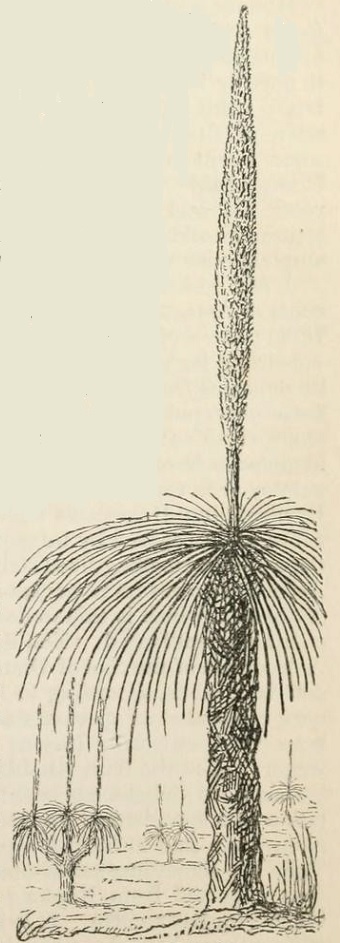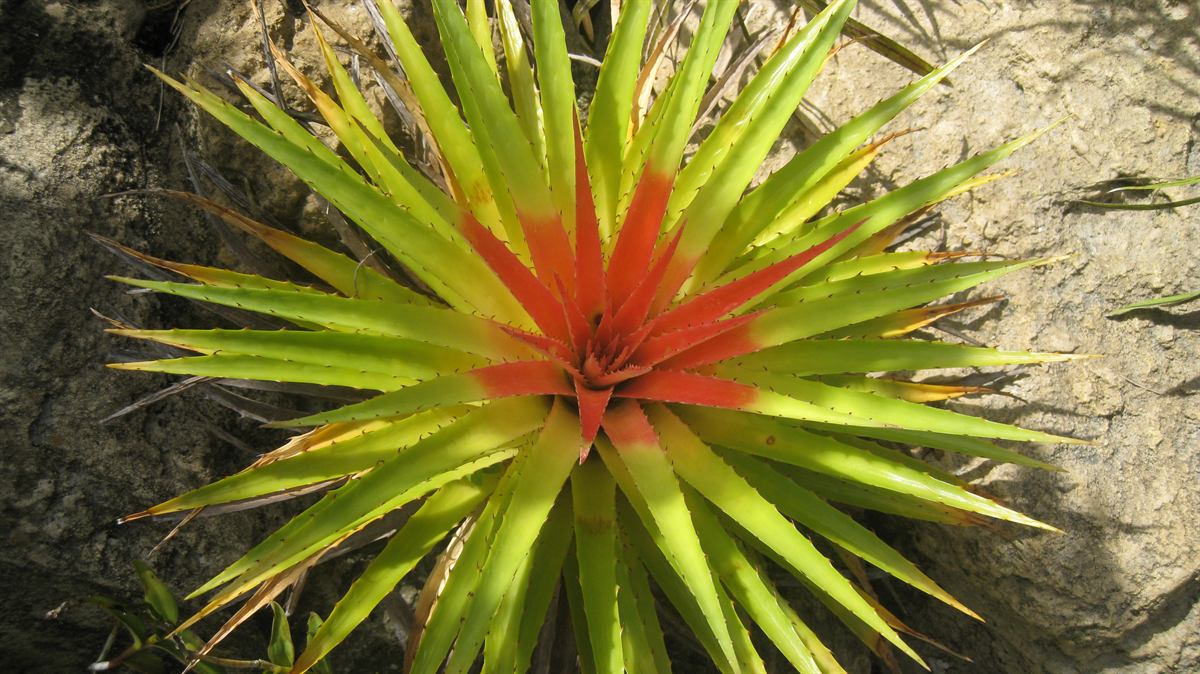|
Commelinoids
In plant taxonomy, commelinids (originally commelinoids) (plural, not capitalised) is a clade of flowering plants within the monocots, distinguished by having cell walls containing ferulic acid. The commelinids are the only clade that the APG IV system has informally named within the monocots. The remaining monocots are a Paraphyly, paraphyletic unit. Also known as the commelinid monocots it forms one of three groupings within the monocots, and the final branch; the other two groups are the alismatid monocots and the lilioid monocots. Description Members of the commelinid clade have cell walls containing UV-Fluorescence, fluorescent ferulic acid. Taxonomy The commelinids were first recognized as a formal group in 1967 by Armen Takhtajan, who named them the Commelinidae and assigned them to a subclass of Liliopsida (monocots). The name was also used in the 1981 Cronquist system. However, by the release of his 1980 system of classification, Takhtajan had merged this subclass in ... [...More Info...] [...Related Items...] OR: [Wikipedia] [Google] [Baidu] |
Lilioid Monocots
Lilioid monocots (lilioids, liliid monocots, petaloid monocots, petaloid lilioid monocots) is an informal name used for a grade (grouping of taxa with common characteristics) of five monocot orders ( Petrosaviales, Dioscoreales, Pandanales, Liliales and Asparagales) in which the majority of species have flowers with relatively large, coloured tepals. This characteristic is similar to that found in lilies ("lily-like"). Petaloid monocots refers to the flowers having tepals which all resemble petals ( petaloid). The taxonomic terms Lilianae or Liliiflorae have also been applied to this assemblage at various times. From the early nineteenth century many of the species in this group of plants were put into a very broadly defined family, Liliaceae '' sensu lato'' or ''s.l.'' (lily family). These classification systems are still found in many books and other sources. Within the monocots the Liliaceae ''s.l.'' were distinguished from the Glumaceae. The development of molecular phy ... [...More Info...] [...Related Items...] OR: [Wikipedia] [Google] [Baidu] |
Arecales
Arecales is an order of flowering plants. The order has been widely recognised only for the past few decades; until then, the accepted name for the order including these plants was Principes. Taxonomy The APG IV system of 2016 places Dasypogonaceae in this order, after studies showing Dasypogonaceae as sister to Arecaceae. However, this decision has been called into question. Historical taxonomical systems The Cronquist system of 1981 assigned the order to the subclass Arecidae in the class Liliopsida (= monocotyledons). The Thorne system (1992) and the Dahlgren system assigned the order to the superorder Areciflorae, also called Arecanae in the subclass Liliidae (= monocotyledons), with the single family Arecaceae. The APG II system of 2003 recognised the order and placed it in the clade commelinids in the monocots and uses this circumscription: * order Arecales *: family Arecaceae The Arecaceae is a family of perennial flowering plants in the monoco ... [...More Info...] [...Related Items...] OR: [Wikipedia] [Google] [Baidu] |
Poales
The Poales are a large order of flowering plants in the monocotyledons, and includes families of plants such as the grasses, bromeliads, and sedges. Sixteen plant families are currently recognized by botanists to be part of Poales. Description The flowers are typically small, enclosed by bracts, and arranged in inflorescences (except in three species of the genus '' Mayaca'', which possess very reduced, one-flowered inflorescences). The flowers of many species are wind pollinated; the seeds usually contain starch. Taxonomy The APG III system (2009) accepts the order within a monocot clade called commelinids, and accepts the following 16 families: The earlier APG system (1998) adopted the same placement of the order, although it used the spelling "commelinoids". It did not include the Bromeliaceae and Mayaceae, but had the additional families Prioniaceae (now included in Thurniaceae), Sparganiaceae (now in Typhaceae), and Hydatellaceae (now transferred out of the monocots; ... [...More Info...] [...Related Items...] OR: [Wikipedia] [Google] [Baidu] |
Monocotyledon
Monocotyledons (), commonly referred to as monocots, ( Lilianae ''sensu'' Chase & Reveal) are grass and grass-like flowering plants (angiosperms), the seeds of which typically contain only one embryonic leaf, or cotyledon. They constitute one of the major groups into which the flowering plants have traditionally been divided; the rest of the flowering plants have two cotyledons and are classified as dicotyledons, or dicots. Monocotyledons have almost always been recognized as a group, but with various taxonomic ranks and under several different names. The APG III system of 2009 recognises a clade called "monocots" but does not assign it to a taxonomic rank. The monocotyledons include about 60,000 species, about a quarter of all angiosperms. The largest family in this group (and in the flowering plants as a whole) by number of species are the orchids (family Orchidaceae), with more than 20,000 species. About half as many species belong to the true grasses ( Poaceae), which are ... [...More Info...] [...Related Items...] OR: [Wikipedia] [Google] [Baidu] |
Bromelianae
Bromeliales is an order of flowering plants. Such an order has been recognized by a few systems of plant taxonomy, with a various placement. It appears that it always has had the same circumscription: consisting only of the family Bromeliaceae, the bromeliad or pineapple family. The order is not recognized in the APG II system, of 2003, which places the plants involved in the order Poales. Some examples are: * The Cronquist system of 1981 placed this order in subclass Zingiberidae, of class Liliopsida monocotyledons * The Thorne system (1992) placed the order in superorder Commelinanae in subclass Liliidae monocotyledons * The Dahlgren system placed the order in superorder Bromeliiflorae (also known as Bromelianae) in subclass Liliidae monocotyledonstogether with five other orders. * The Engler system One of the prime systems of plant taxonomy, the Engler system was devised by Adolf Engler (1844–1930), and is featured in two major taxonomic texts he authored or co-author ... [...More Info...] [...Related Items...] OR: [Wikipedia] [Google] [Baidu] |
Bromeliales
Bromeliales is an order of flowering plants. Such an order has been recognized by a few systems of plant taxonomy, with a various placement. It appears that it always has had the same circumscription: consisting only of the family Bromeliaceae, the bromeliad or pineapple family. The order is not recognized in the APG II system, of 2003, which places the plants involved in the order Poales. Some examples are: * The Cronquist system of 1981 placed this order in subclass Zingiberidae, of class Liliopsida monocotyledons * The Thorne system (1992) placed the order in superorder Commelinanae in subclass Liliidae monocotyledons * The Dahlgren system placed the order in superorder Bromeliiflorae (also known as Bromelianae) in subclass Liliidae monocotyledonstogether with five other orders. * The Engler system One of the prime systems of plant taxonomy, the Engler system was devised by Adolf Engler (1844–1930), and is featured in two major taxonomic texts he authored or co-auth ... [...More Info...] [...Related Items...] OR: [Wikipedia] [Google] [Baidu] |
Dactylis Glomerata
''Dactylis Glomerata'' is the sixth studio album by Swedish doom metal band Candlemass, released in 1998. This was their first album released since their split in 1994. The album was originally destined to be the second release by Candlemass main songwriter Leif Edling's side-project Abstrakt Algebra but, under request from the record label Music for Nations, it was converted in a Candlemass album. There were many musicians involved in the long process of recording, including members of the Abstrakt Algebra's line-up, guitarist Michael Amott of Arch Enemy and Carcass fame and new singer Björn Flodkvist. The music on the album lacks much of the epic doom sound of previous works and embraces a more experimental and progressive approach, with elements of stoner rock and space rock. In 2006, it was reissued by GMR Music as a 2 CD edition. The second disc contains the previously unreleased album ''Abstrakt Algebra II'', from which this album's tracks derived. Background Candlema ... [...More Info...] [...Related Items...] OR: [Wikipedia] [Google] [Baidu] |
Takhtajan System
A system of plant taxonomy, the Takhtajan system of plant classification was published by Armen Takhtajan, in several versions from the 1950s onwards. It is usually compared to the Cronquist system. It admits paraphyletic groups. Systems The first classification was published in Russian in 1954,and came to the attention of the rest of the world after publication of an English translation in 1958 as ''Origin of Angiospermous Plants''. Further versions appeared in 1959 (''Die Evolution der Angiospermen'') and 1966 (''Sistema i filogeniia tsvetkovykh rastenii''). The latter popularised Takhtajan's system when it appeared in English in 1969 (Flowering plants: Origin and dispersal). A further revision appeared in 1980. 1966 system * Magnoliophyta ( Angiospermae) p. 51 ** Class: Magnoliatae ( Dicotyledones) p. 51 ** Class: Liliatae ( Monocotyledones) p. 461 *** Subclass A: Alismidae p. 461 *** Subclass B: Liliidae p. 473 (was ''nom. nov.'') **** Super ... [...More Info...] [...Related Items...] OR: [Wikipedia] [Google] [Baidu] |
Haemodorales
Commelinales is an order of flowering plants. It comprises five families: Commelinaceae, Haemodoraceae, Hanguanaceae, Philydraceae, and Pontederiaceae. All the families combined contain over 885 species in about 70 genera; the majority of species are in the Commelinaceae. Plants in the order share a number of synapomorphies that tie them together, such as a lack of mycorrhizal associations and tapetal raphides. Estimates differ as to when the Commelinales evolved, but most suggest an origin and diversification sometime during the mid- to late Cretaceous. Depending on the methods used, studies suggest a range of origin between 123 and 73 million years, with diversification occurring within the group 110 to 66 million years ago. The order's closest relatives are in the Zingiberales, which includes ginger, bananas, cardamom, and others.Stevens, P. F. (2001 onwards). Angiosperm Phylogeny Website. Version 9, November 2011. Taxonomy According to the most recent classification sch ... [...More Info...] [...Related Items...] OR: [Wikipedia] [Google] [Baidu] |


